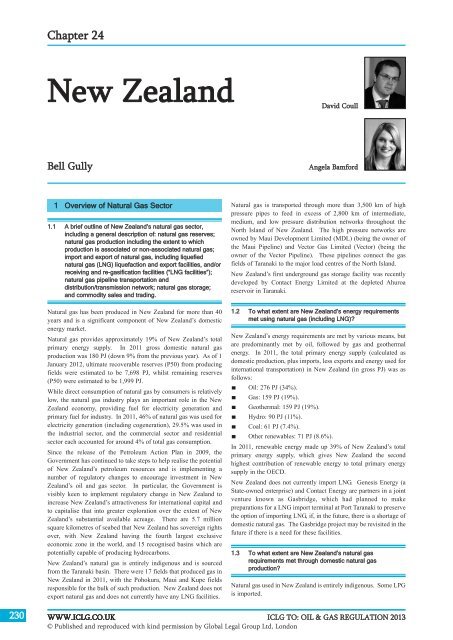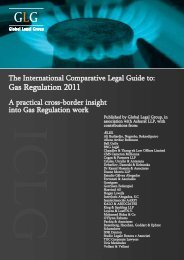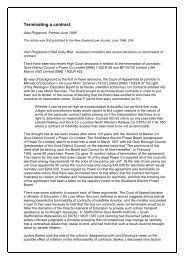Oil & Gas Regulation 2013
NZ Oil & Gas Chapter - The International Comparative ... - Bell Gully
NZ Oil & Gas Chapter - The International Comparative ... - Bell Gully
You also want an ePaper? Increase the reach of your titles
YUMPU automatically turns print PDFs into web optimized ePapers that Google loves.
Chapter 24<br />
New Zealand<br />
David Coull<br />
Bell Gully<br />
Angela Bamford<br />
1 Overview of Natural <strong>Gas</strong> Sector<br />
1.1 A brief outline of New Zealand’s natural gas sector,<br />
including a general description of: natural gas reserves;<br />
natural gas production including the extent to which<br />
production is associated or non-associated natural gas;<br />
import and export of natural gas, including liquefied<br />
natural gas (LNG) liquefaction and export facilities, and/or<br />
receiving and re-gasification facilities (“LNG facilities”);<br />
natural gas pipeline transportation and<br />
distribution/transmission network; natural gas storage;<br />
and commodity sales and trading.<br />
Natural gas has been produced in New Zealand for more than 40<br />
years and is a significant component of New Zealand’s domestic<br />
energy market.<br />
Natural gas provides approximately 19% of New Zealand’s total<br />
primary energy supply. In 2011 gross domestic natural gas<br />
production was 180 PJ (down 9% from the previous year). As of 1<br />
January 2012, ultimate recoverable reserves (P50) from producing<br />
fields were estimated to be 7,698 PJ, whilst remaining reserves<br />
(P50) were estimated to be 1,999 PJ.<br />
While direct consumption of natural gas by consumers is relatively<br />
low, the natural gas industry plays an important role in the New<br />
Zealand economy, providing fuel for electricity generation and<br />
primary fuel for industry. In 2011, 46% of natural gas was used for<br />
electricity generation (including cogeneration), 29.5% was used in<br />
the industrial sector, and the commercial sector and residential<br />
sector each accounted for around 4% of total gas consumption.<br />
Since the release of the Petroleum Action Plan in 2009, the<br />
Government has continued to take steps to help realise the potential<br />
of New Zealand’s petroleum resources and is implementing a<br />
number of regulatory changes to encourage investment in New<br />
Zealand’s oil and gas sector. In particular, the Government is<br />
visibly keen to implement regulatory change in New Zealand to<br />
increase New Zealand’s attractiveness for international capital and<br />
to capitalise that into greater exploration over the extent of New<br />
Zealand’s substantial available acreage. There are 5.7 million<br />
square kilometres of seabed that New Zealand has sovereign rights<br />
over, with New Zealand having the fourth largest exclusive<br />
economic zone in the world, and 15 recognised basins which are<br />
potentially capable of producing hydrocarbons.<br />
New Zealand’s natural gas is entirely indigenous and is sourced<br />
from the Taranaki basin. There were 17 fields that produced gas in<br />
New Zealand in 2011, with the Pohokura, Maui and Kupe fields<br />
responsible for the bulk of such production. New Zealand does not<br />
export natural gas and does not currently have any LNG facilities.<br />
Natural gas is transported through more than 3,500 km of high<br />
pressure pipes to feed in excess of 2,800 km of intermediate,<br />
medium, and low pressure distribution networks throughout the<br />
North Island of New Zealand. The high pressure networks are<br />
owned by Maui Development Limited (MDL) (being the owner of<br />
the Maui Pipeline) and Vector <strong>Gas</strong> Limited (Vector) (being the<br />
owner of the Vector Pipeline). These pipelines connect the gas<br />
fields of Taranaki to the major load centres of the North Island.<br />
New Zealand’s first underground gas storage facility was recently<br />
developed by Contact Energy Limited at the depleted Ahuroa<br />
reservoir in Taranaki.<br />
1.2 To what extent are New Zealand’s energy requirements<br />
met using natural gas (including LNG)?<br />
New Zealand’s energy requirements are met by various means, but<br />
are predominantly met by oil, followed by gas and geothermal<br />
energy. In 2011, the total primary energy supply (calculated as<br />
domestic production, plus imports, less exports and energy used for<br />
international transportation) in New Zealand (in gross PJ) was as<br />
follows:<br />
<strong>Oil</strong>: 276 PJ (34%).<br />
<strong>Gas</strong>: 159 PJ (19%).<br />
Geothermal: 159 PJ (19%).<br />
Hydro: 90 PJ (11%).<br />
Coal: 61 PJ (7.4%).<br />
Other renewables: 71 PJ (8.6%).<br />
In 2011, renewable energy made up 39% of New Zealand’s total<br />
primary energy supply, which gives New Zealand the second<br />
highest contribution of renewable energy to total primary energy<br />
supply in the OECD.<br />
New Zealand does not currently import LNG. Genesis Energy (a<br />
State-owned enterprise) and Contact Energy are partners in a joint<br />
venture known as <strong>Gas</strong>bridge, which had planned to make<br />
preparations for a LNG import terminal at Port Taranaki to preserve<br />
the option of importing LNG, if, in the future, there is a shortage of<br />
domestic natural gas. The <strong>Gas</strong>bridge project may be revisited in the<br />
future if there is a need for these facilities.<br />
1.3 To what extent are New Zealand’s natural gas<br />
requirements met through domestic natural gas<br />
production?<br />
Natural gas used in New Zealand is entirely indigenous. Some LPG<br />
is imported.<br />
230 WWW.ICLG.CO.UK<br />
ICLG TO: OIL & GAS REGULATION <strong>2013</strong><br />
© Published and reproduced with kind permission by Global Legal Group Ltd, London








